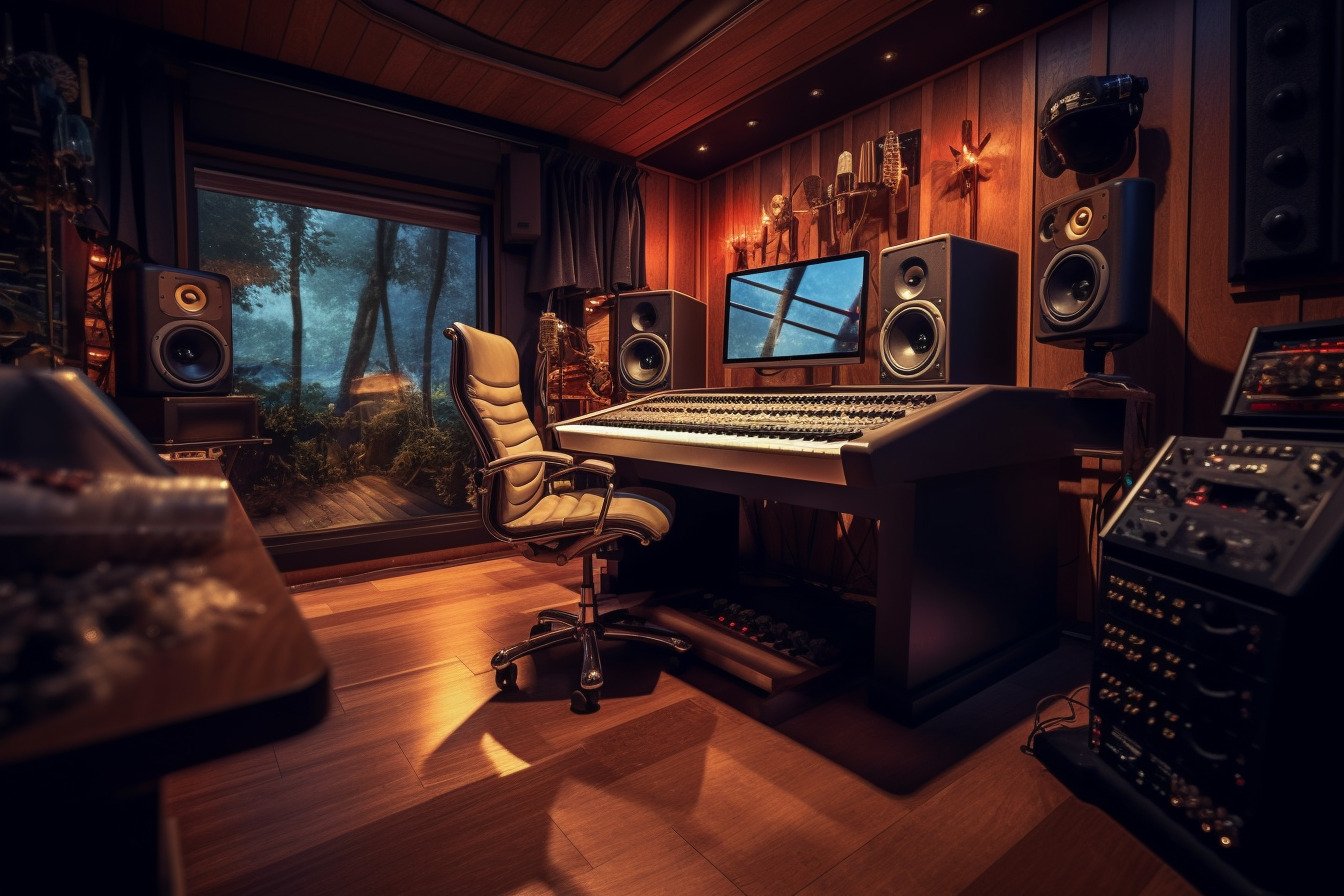Brief Overview of Streaming Music on Twitch
Twitch is a powerful platform that’s redefining the landscape of live streaming, with a particular emphasis on gaming. However, it also holds vast potential for streaming music. From DJs spinning tracks live, to musicians performing their original compositions, to casual streamers looking to enhance their gaming broadcasts with music, Twitch provides a virtual stage for all.
When used effectively, music can significantly improve the quality of your stream by setting the mood, engaging your audience, and providing entertainment during downtimes. It’s not just about playing songs in the background of your gaming sessions; it can also be about broadcasting music creation processes, hosting live performances, and even engaging with other musicians on the platform. The possibilities are virtually endless.
Importance of Streaming Music Correctly to Avoid Bans and Build an Audience
But with great power comes great responsibility. Streaming music on Twitch is not as straightforward as it might seem. To ensure the sustainability of your channel and your reputation as a streamer, it’s vital to abide by Twitch’s music policies, which are heavily influenced by copyright laws.
Playing copyrighted music without proper permissions can lead to severe consequences, including DMCA takedowns, strikes against your Twitch account, and in the worst case, permanent bans. Not only does this disrupt your streaming schedule, but it can also erode trust among your viewers, hindering your ability to build a loyal audience.
Equally crucial is understanding how to use music to draw in and retain viewers. As Twitch is a highly saturated platform, standing out and attracting a dedicated viewer base can be a challenge. Implementing effective strategies to engage your audience, consistent streaming, developing a unique music identity, and promoting your stream effectively are key to overcoming this challenge.
In the following sections, we’ll delve deeper into how to navigate these aspects, helping you stream music on Twitch like a pro.
Understanding Twitch’s Music Policies
Explanation of Twitch’s Terms of Service
Before you start streaming music on Twitch, it’s crucial to familiarize yourself with Twitch’s Terms of Service (ToS). These terms define the rules and guidelines that all users must abide by while using the platform. The ToS encompass a wide range of topics, including community guidelines, privacy policy, and, notably, music and copyright guidelines.
Twitch’s ToS is designed to protect both the streamers and the rights of copyright holders, and as such, it requires that all users ensure they have the necessary rights to all content they share on the platform, including music.
Details of Twitch’s Music-Related Rules and Guidelines
Twitch has a stringent policy when it comes to music. Twitch’s music-related guidelines explicitly state that creators can only share music on Twitch in the following circumstances:
- They have the necessary rights and permissions to use the music, including the rights to the underlying lyrics and melody.
- They are performing music that is in the public domain.
- They are creating their own original music.
- They are using Twitch Sings performances, which is licensed for use on Twitch.
- They are using music that is freely available for use and sharing, like certain tracks from Twitch’s Soundtrack tool or other similar royalty-free sources.
The platform takes copyright very seriously, and it has automated systems to detect and mute unauthorized copyrighted music, in addition to user-driven reports.
Consequences of Violations
If you play copyrighted music without proper permission, your streams can be muted, flagged, or even taken down due to Digital Millennium Copyright Act (DMCA) strikes. Repeated violations can lead to penalties ranging from temporary suspension to permanent bans.
Moreover, copyright owners can take legal action against streamers who repeatedly infringe their copyrights, leading to potential financial penalties. Twitch is obligated by law to comply with DMCA takedown requests, and they will not intercede in such legal matters. Therefore, understanding Twitch’s music policy and complying with it is vital for streamers.
Avoiding Bans
Using Royalty-Free and Twitch-Approved Music
Royalty-free music refers to music that you can use without having to pay ongoing royalties for its usage. Essentially, you pay once (or not at all, depending on the source), and you can use it as much as you want, depending on the license agreement.
It’s important to note that ‘royalty-free’ does not mean ‘free.’ It simply means that you don’t have to pay each time you use the music. Some royalty-free music is available for free, while others require a one-time payment or subscription.
Recommended Sources for Twitch-Approved Music
There are numerous sources where you can find Twitch-approved, royalty-free music:
- Twitch Soundtrack: A library of approved music you can play on your stream without worrying about DMCA issues.
- Monstercat Gold: For a monthly fee, you can access a catalog of electronic music and sync your account with Twitch to clear any potential DMCA claims.
- Pretzel Rocks: A music service offering a wide range of royalty-free music that you can use during your streams.
- Epidemic Sound: This site provides access to thousands of tracks with a subscription, and they offer a creator subscription that includes Twitch clearance.
Understanding and Acquiring Necessary Rights for Copyrighted Music
The crux of copyright laws for music is that the owner of the music has exclusive rights to perform, reproduce, and distribute their music. This means that if you want to play copyrighted music on your Twitch stream, you technically need to secure the rights to do so.
Steps to Acquiring the Rights to Stream Copyrighted Music
While obtaining rights can be complex, here are the basic steps:
- Identify the copyright holders: This may be the artist, record label, or a publishing company.
- Contact the copyright holders: Send a formal request to use their music.
- Negotiate a license: If they respond positively, they may grant you a license for a fee, which could be a one-time payment or a recurring fee.
Keep in mind that the process can be lengthy and potentially costly, with no guarantee of success.
Utilizing Twitch’s Soundtrack Feature
Soundtrack by Twitch is a tool developed by Twitch to provide creators with a curated set of songs that are cleared for use in live streams. The music comes from independent artists who want to share their music with Twitch’s community.
Pros and Cons of Using Twitch’s Soundtrack
Pros:
- Soundtrack is free to use for all Twitch streamers.
- The music is automatically separated from your stream audio, preventing it from being included in your VODs, thus helping to avoid DMCA takedowns.
Cons:
- The selection, while growing, is still limited compared to mainstream music libraries.
- Soundtrack’s music separation technology is not compatible with all streaming software.
Building a Loyal Audience
Interacting with Viewers During Streams
Interacting with viewers is crucial for building a loyal audience. Responding to chat, answering questions, and acknowledging new followers or subscribers can make viewers feel noticed and appreciated. It creates a sense of community and encourages viewers to return and participate in future streams.
Responding to Viewer Comments and Feedback
Viewers often provide valuable feedback. Taking the time to read and respond to their comments can not only help improve your streams but also show your viewers that their opinions matter. It’s a way of showing respect and appreciation for your audience.
Consistency in Streaming
A consistent streaming schedule lets your viewers know when they can expect to see you online. Posting this schedule on your Twitch profile and social media accounts can help attract and retain viewers. Try to stick to your schedule as closely as possible.
Keeping to the Schedule to Build Reliability
Reliability builds trust among your audience. If you commit to streaming at specific times, make sure you follow through. Regular viewers might plan their time around your streams, so it’s important to respect that.
Developing a Unique Musical Identity
Selecting a Niche or Genre
Choose a musical genre or niche that suits your style and interests. It could be anything from electronic music, jazz, indie rock, or video game soundtracks. This will attract viewers with similar interests and make your stream stand out.
Curating a Distinct Playlist
Make your music playlist a unique aspect of your stream. Handpick each song to ensure it fits the vibe you want for your stream. A well-curated playlist can make your stream more enjoyable and memorable.
Importance of Cross-Platform Promotion
Promoting your Twitch streams on other platforms can significantly increase your visibility. Sharing updates, highlights, and stream schedules on platforms like Twitter, Instagram, and YouTube can help attract a wider audience.
Strategies for Effective Promotion
Effective promotion involves more than just posting your streaming schedule. Share highlights from your streams, engage with your followers, collaborate with other streamers, and participate in relevant online communities. Each of these activities can contribute to building your audience and increasing your Twitch visibility.
Enhancing Your Stream with Music
Techniques for Incorporating Music Effectively into Streams
The right approach to incorporating music into your stream can significantly enhance viewer experience. Here are some techniques to consider:
- Use Music to Fill Downtime: Playing music during breaks or moments of downtime can keep viewers engaged.
- Theme Songs: Use a specific song or tune to start and end your streams. This creates a signature sound that viewers associate with your stream.
- Music Requests: Allow your viewers to request songs. This not only keeps them engaged but also gives you insights into their music preferences.
Balancing Music Volume with Game Volume and Commentary
The balance between music volume, game volume, and commentary is critical to maintaining a pleasant viewing experience.
- Background Music: If you’re playing music in the background while you talk or play a game, make sure the music is not overpowering. Your viewers should be able to hear your voice clearly.
- Game Sound: Game sounds and effects should also be audible, but not louder than your voice. Adjust the game’s audio settings if necessary.
- Testing: Always test your sound levels before going live. Listen to your own stream to check the balance, and adjust accordingly.
Tips for Creating a Mood or Atmosphere with Music
Music has a strong impact on the mood and atmosphere of your stream. Use it wisely to enhance the viewer experience.
- Match the Mood: Choose music that fits the mood of your stream. If you’re playing a high-action game, for instance, choose energetic and fast-paced music.
- Genre Selection: The genre of music can also set a mood. For a chill, relaxed stream, consider lo-fi beats or ambient music.
- Viewer Preferences: Keep your audience in mind when choosing music. If your viewers prefer a certain genre or artist, including them in your playlist can make your stream more appealing to them.
Case Studies: Successful Music Streamers on Twitch
Overview of Successful Music Streamers
There are numerous music streamers on Twitch who have managed to gain substantial followings and carve a niche for themselves. A few examples include:
- HermanLi: The lead guitarist for the power metal band DragonForce, HermanLi streams live guitar playthroughs, music production, and behind-the-scenes looks at the band’s operations. He’s also known for his interactive and engaging community.
- A_Seagull: Though primarily a gamer, A_Seagull has curated a unique musical identity through his stream’s background music, often focusing on chill and lo-fi beats that complement his gaming content.
- Lara6683: Lara6683 is a musician who performs live piano and violin music on Twitch, taking song requests from viewers and interacting with them.
Analysis of Their Strategies and Practices
Examining these successful music streamers, certain common strategies and practices emerge:
- Interactivity: These streamers frequently interact with their viewers, whether by responding to chat, taking song requests, or engaging in discussions.
- Unique Content: Each streamer offers something unique—HermanLi with his live playthroughs and band insights, A_Seagull with his music-enhanced gaming streams, and Lara6683 with her live performances.
- Consistency: All these streamers maintain consistent schedules, so their viewers know when to tune in.
- Cross-Platform Engagement: They also maintain active social media presences, promoting their streams and engaging with their viewers off Twitch as well.
By incorporating these practices into your own streaming strategy, you too can work towards building a successful music stream on Twitch.
Conclusion
Recap of the Importance of Proper Music Streaming and Audience Building on Twitch
Streaming music on Twitch offers a plethora of opportunities, from enhancing gaming streams to hosting live performances. However, doing it right requires a thorough understanding of Twitch’s music policies, strategic use of copyright-friendly music, and effectively incorporating music into your streams.
Beyond the music itself, building a loyal audience on Twitch requires consistent interaction and engagement, maintaining a reliable streaming schedule, developing a unique musical identity, and promoting your streams across various platforms.
Encouragement for Budding Twitch Streamers
For those embarking on their Twitch journey, remember that every successful streamer started somewhere. Learning the ropes, understanding your audience, and refining your stream to suit your style and your viewers’ preferences are all part of the process.
While challenges will inevitably arise, stay patient, persistent, and positive. With the right approach to streaming music and audience engagement, you too can carve out your niche on Twitch and cultivate a community around your shared love for music.










